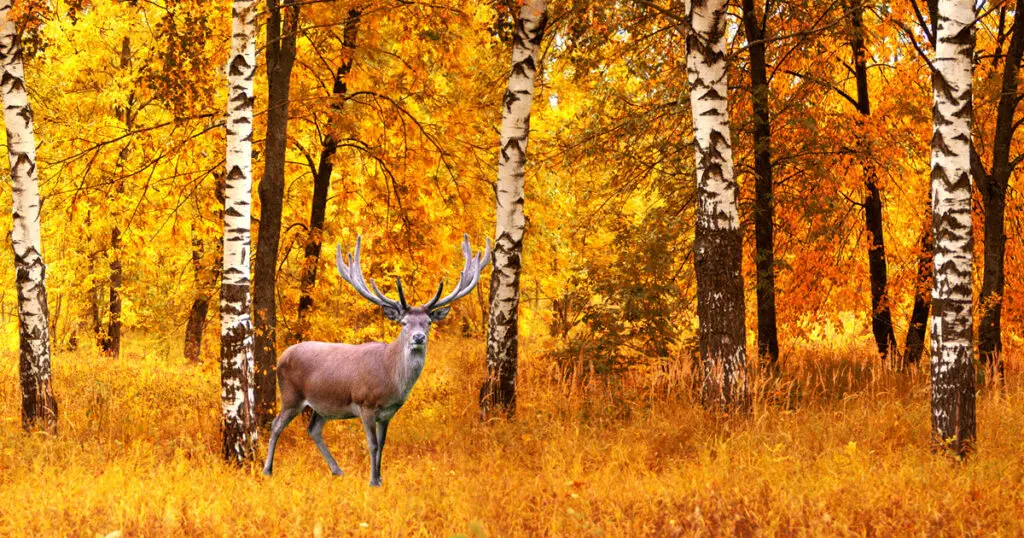Did you know there are 47 species of deer found around the world? Each has its own characteristics, including variations in size and weight. While each deer species has an average weight range, there are certain factors that may cause variations. Today I’ll answer the question How Much Does a Deer Weigh?, but I’ll do so within the context of different species of deer and the range of environmental factors which can lead to weight fluctuations within each species.
Let’s begin with a discussion of these environmental and seasonal factors which can impact the weight of a deer.
After that, we’ll take a look at a table with the average weight of various deer species, and we’ll also look at the weight of deer based on chest girth measurements so you can understand what to expect in terms of live weight, dressed weight, and the amount of edible meat from deer of different sizes.
Seasonal Weight Fluctuations in Deer
There are certain times of year and environmental circumstances that may create fluctuations in a deer’s weight. These include the season (and the amount of forage available and the parasite load of deer populations).
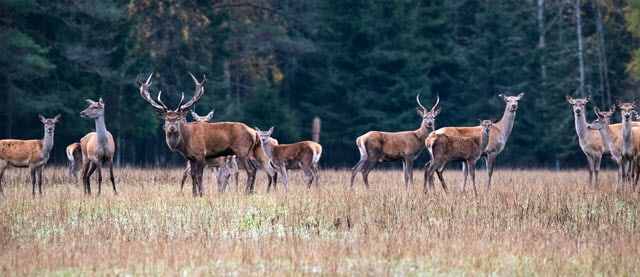
The time of a deer’s reproductive and mating cycle can play a role as well.
Seasons, Breeding and Deer Weight Fluctuations
The way seasons will have an impact on deer weight depends on the climate in which they live and their species. For example, certain kinds of deer that live in climates with cold winters have to fatten in the fall to survive that cold time of year.
An example is the Whitetail deer. This species will eat a great deal in the summer and fall, making sure it gains weight and fat reserves to get through the winter.
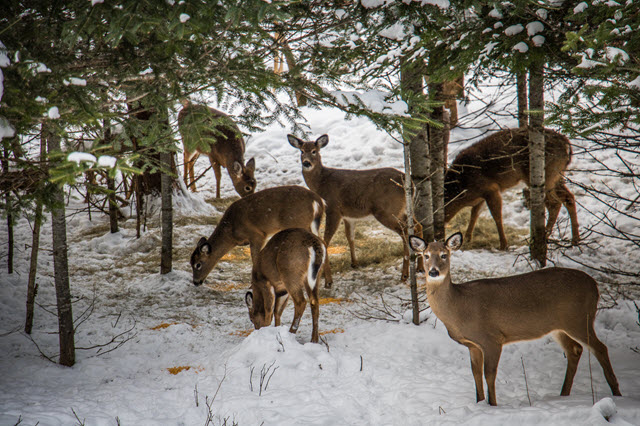
Male deer (also referred to as bucks) have an especially difficult challenge, as they often lose a quarter of their total body weight during the rut (breeding) period. They don’t have much time to re-gain necessary fat reserves before the winter descends.
Chart: Deer Body Weights
Below is our list of most of the different deer species and their average weights (listed in both pounds and kilograms).
How Much Every Type of Deer Weighs
| Deer Species | Average Weight (pounds) | Average Weight (kilograms) |
|---|---|---|
| White-Tailed Deer | 150 lbs | 68 kg |
| Red Deer | 440 lbs | 200 kg |
| Roe Deer | 22-77 lbs | 10-35 kg |
| Reindeer | 375 lbs | 170 kg |
| Moose | 840-1540 lbs | 380-700 kg |
| Mule Deer | 55-150 lbs | 25-68 kg |
| Fallow Deer | 100-175 lbs | 46-80 kg |
| Elk | 705 lbs | 320 kg |
| Chital | 80 lbs | 36 kg |
| Red Brocket | 45 lbs | 20 kg |
| Sambar Deer | 400 lbs | 180 kg |
| South Andean Deer | 155 lbs | 70 kg |
| Eld’s Deer | 210 lbs | 95 kg |
| Reeves’s Muntjac | 28 lbs | 13 kg |
| Sika Deer | 90 lbs | 42 kg |
| Indian Hog Deer | 75 lbs | 35 kg |
| Calamian Deer | 90 lbs | 40 kg |
| Siberian Roe Deer | 90 lbs | 40 kg |
| Pygmy Brocket | 35 lbs | 16 kg |
| Dwarf Brocket | 35 lbs | 16 kg |
| Southern Pudu | 21 lbs | 9.6 kg |
| Northern Pudu | 21 lbs | 9.6 kg |
| Indian Muntjac | 40 lbs | 18 kg |
| Pere David’s Deer | 375 lbs | 170 kg |
| Barasingha | 375 lbs | 170 kg |
| Fea’s Muntjac | 45 lbs | 20 kg |
| Hairy-Fronted Muntjac | 40 lbs | 18 kg |
| Taruca | 100 lbs | 45 kg |
| Philippine Deer | 110 lbs | 49 kg |
| Little Red Brocket | 45 lbs | 20 kg |
| Giant Muntjac | 80 lbs | 36 kg |
| Thorold’s Deer | 310 lbs | 140 kg |
| Javan Rusa | 145 lbs | 65 kg |
| Visayan Spotted Deer | 100 lbs | 45 kg |
| Merida Brocket | 35 lbs | 16 kg |
| Gongshan Muntjac | 40 lbs | 18 kg |
| Schomburghk’s Deer | 240 lbs | 110 kg |
| Brown Brocket | 40 lbs | 18 kg |
| Bornean Yellow Muntjac | 40 lbs | 18 kg |
| Tufted Deer | 50 lbs | 23 kg |
Why Do Individual Deer Vary in Weight
Some beginner deer enthusiasts wonder why individual deer vary in weight. Why doesn’t each individual deer of a species weigh pretty much the same as its companions?
Of course, male deer weigh more than female deer. For example, in the Red Deer species, an average stag weighs between 150 and 300 pounds (59 and 136 kilograms). The record largest male red deer is 375 pounds (170 kilograms). In female (doe) red deer, the average weight is between 90 and 200 pounds (41 to 91 kilograms).
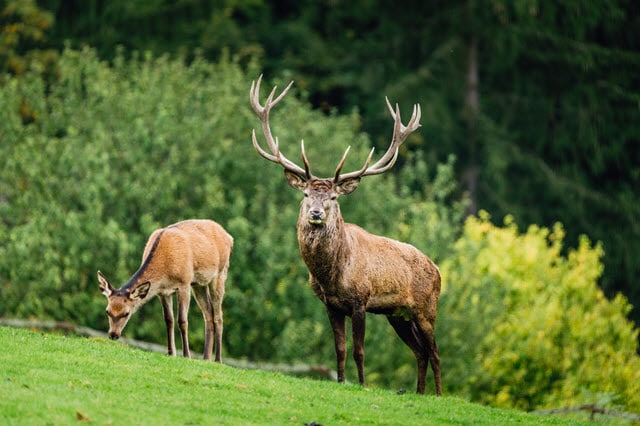
But the variation goes further than that. Individual deer vary in weight because of a number of factors, including variations in the weight of different parts of their body:
- Flesh (meat)
- Hide
- Bones
- Blood
The age and health of a deer can also play a role in how much it weighs.
Weight Components Variation
We’ll continue talking about the Red Deer to discuss how males and females tend to vary in terms of how their weights are comprised.
First let’s take a look at how much the deer’s blood comprises its weight in red deer bucks and does. In an average red deer doe, the blood will comprise 5% of the animal’s total body mass. In the average red deer buck, the blood will comprise about 5%. So as we see in both males and females of this breed, the average for how much of body mass the blood comprises is the same.
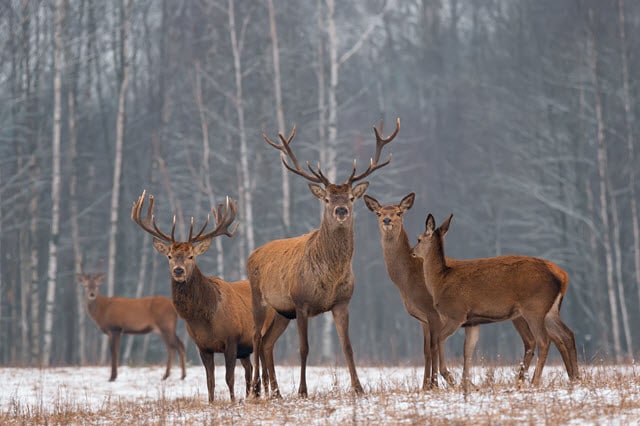
When it comes to skin (hide), there is a difference in what percentage of the mass this comprises. In red deer bucks, it comprises 8.7% of total body mass. In does, it comprises 7.9% of total body mas. Above average male red deer may have a hide that accounts for an average of 9% of body mass.
There’s a difference when it comes to skeletal frames, too. In red deer bucks, the bones will on average comprise about 12.4% of body weight. But, in an above average male red deer, the bones will comprise a lower percentage of body weight, at 11.7%. In the does, the deer’s bones will comprise more of its mass, at about 13%.
Other components of deer body weight include the flesh (meat) and organs, as well as a limited amount of fat. Deer are generally lean animals. This means that usually flesh will take up slightly less than 50% of total weight. About 22% of a deer’s weight when it’s alive will be comprised of its organs.
Field Dressing Changes Deer Weight
A deer’s weight will change after a hunter does field dressing. Field dressing is a necessary procedure when you hunt deer or any other kind of wild animal.
One of the first processes involved in field dressing a deer is taking out the animal’s vital organs as promptly as possible. This is crucially important, as if you don’t do this quickly enough, the deer’s meat may become exposed to bacteria and spoil. When this happens, the meat is dangerous and must never be eaten.
While we’ve provided information on the average weight of deer organs, there will be some variation from deer to deer. When trying to figure out how much your deer will weigh after you’ve field dressed it and removed the organ weight, knowing the weight averages for organs and other parts of the body will help you estimate the amount of meat you can expect to harvest from the animal.
In other words, understanding and knowing the average live weights of deer and the fact that the dressed weight will not include certain components of the body will help you get a general idea of how much your dressed deer will weigh.
Why Should You Care About a Deer’s Dressed Weight?
If you hunt deer, you need to get an as accurate idea of deer dressed weight as possible.
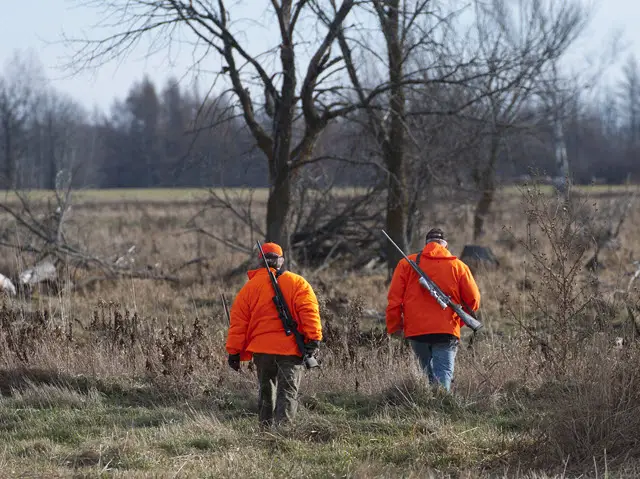
When you understand dressed weight, you can get a general idea of how much deer meat you will end up with. Luckily, there’s a calculation you can use to figure out a deer’s approximate dressed weight. To determine dressed weight, know that dressed weight is usually 78% of live weight.
To calculate this, multiply the live weight of the deer by 0.78. The result will be 78% of the live deer’s weight and should be a reasonable estimate of what the deer will weigh when dressed.
What is a Deer’s Hanging Weight?
A deer’s hanging weight is different from dressed weight. The hanging weight is measured after hide removal, and after you have removed the feet and head.
There is a calculation for figuring out a deer’s hanging weight as well. Simply divide the deer’s dressed weight (also referred to as Field Dress Weight) by 1.33.
How Much Edible Venison Will a Deer Yield?
Venison, of course, is deer meat. After you dress the deer, you collect its meat (venison). There are two kinds of meat weight. One is referred to as the realistic weight, and the other is called the ideal boneless weight.
If you want to calculate how much edible venison you’ll get from a deer, take the deer’s hanging weight and divide this by 1.35. If you want to calculate the realistic venison weight, take the ideal venison weight and multiply it by 70%.
Remember These Numbers are Estimates
Each deer is an individual animal, and it will have individual variations. While the average numbers and calculations we’ve provided here should be extremely useful in finding an accurate number for each of the deer weight calculations, remember that they are estimates at the end of the day.
Be prepared for there to be differences in the deer that you hunt.
Shooting Method Plays a Part
It may sound counterintuitive, but the method you use for shooting a deer will also play a significant part in the amount of venison you get from the animal.
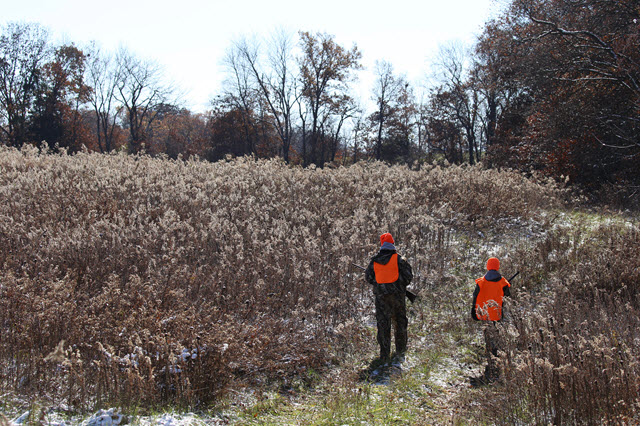
If you shoot the deer in a way that puts the bullet into the bones, or into especially meaty regions of the animal, you will have a lower amount of venison in the yield.
You should learn how to shoot deer correctly to get the best possible yield. If you don’t, there will be some waste, and you will not be able to harvest as much of the deer’s meat.
Deer Weight by Chest (Girth) Measurement
You can use chest and girth measurements to help figure out weight estimates for a deer. Below is a chart with information that will assist with this process. Chest measurement is also referred to as girth measurement.
To measure a deer’s chest, measure immediately behind its front legs. Edible meat refers to edible venison that is free from bones.
| Deer Chest Measurement | Live Weight of Deer | Deer Weight (after field dressing) | Weight of Edible Meat (estimate) |
|---|---|---|---|
| 48 inches | 340 pounds | 272 pounds | 153 pounds |
| 47 inches | 310 pounds | 251 pounds | 139 pounds |
| 46 inches | 290 pounds | 233 pounds | 130 pounds |
| 45 inches | 267 pounds | 214 pounds | 120 pounds |
| 44 inches | 244 pounds | 198 pounds | 110 pounds |
| 43 inches | 228 pounds | 182 pounds | 103 pounds |
| 42 inches | 210 pounds | 170 pounds | 94 pounds |
| 41 inches | 195 pounds | 156 pounds | 88 pounds |
| 40 inches | 182 pounds | 144 pounds | 80 pounds |
| 39 inches | 169 pounds | 135 pounds | 74 pounds |
| 38 inches | 157 pounds | 126 pounds | 71 pounds |
| 37 inches | 146 pounds | 115 pounds | 66 pounds |
| 36 inches | 135 pounds | 104 pounds | 61 pounds |
| 35 inches | 126 pounds | 99 pounds | 57 pounds |
| 34 inches | 118 pounds | 91 pounds | 54 pounds |
| 33 inches | 110 pounds | 87 pounds | 50 pounds |
| 32 inches | 102 pounds | 80 pounds | 45 pounds |
| 31 inches | 98 pounds | 74 pounds | 42 pounds |
| 30 inches | 90 pounds | 70 pounds | 39 pounds |
| 29 inches | 82 pounds | 64 pounds | 36 pounds |
| 28 inches | 77 pounds | 59 pounds | 34 pounds |
| 27 inches | 71 pounds | 53 pounds | 31 pounds |
| 26 inches | 66 pounds | 49 pounds | 30 pounds |
| 25 inches | 61 pounds | 43 pounds | 29 pounds |
| 24 inches | 55 pounds | 38 pounds | 27 pounds |
| 23 inches | 50 pounds | 35 pounds | 24 pounds |
| 22 inches | 45 pounds | 32 pounds | 22 pounds |
| 21 inches | 41 pounds | 29 pounds | 20 pounds |
| 20 inches | 37 pounds | 26 pounds | 18 pounds |
What Are The 3 Heaviest Deer Species in the World?
You may be wondering about the biggest and heaviest deer species in the world, and while you can compare the average weight of different types of deer in the table on this page, here’s a quick list of the deer species that weigh the most:
- Moose are the heaviest deer species in the world (average weight 840 – 1,540 pounds)
- North American Elk are the second heaviest species of deer in the world (average weight 705 pounds)
- Sambar Deer are the third heaviest species in the world (average weight 400 pounds)
Let’s take a closer look at each of these large types of deer.
Heaviest Deer Species in the World: The Moose
The moose is the heaviest and largest species of deer on the planet. The average weight for moose is between 840 and 1,540 pounds (380 to 700 kilograms). The heaviest moose ever found and weighed was 1,800 pounds (816 kilograms). It was shot in 1897 in Alaska, and it was an Alces alces gigas (Alaskan moose).
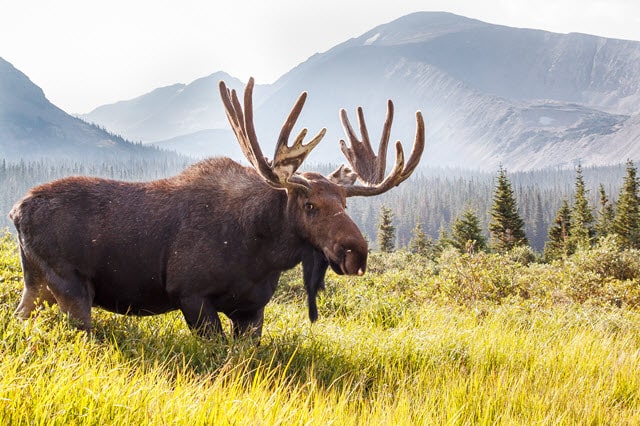
Moose are native to several parts of North America, specifically in Northern Canada and the far-northern United States. There are also moose found in Europe. In Europe, however, they’re not called moose. They’re referred to as Eurasian elk.
The moose is North America’s tallest mammal. When measured from shoulder to roof, their height ranges between 5 feet to 6.5 feet. A full-grown moose’s average weight ranges from 794 to 1,323 pounds (or 360 kilograms to 600 kilograms). A full-grown female moose’s average weight ranges between 595 and 882 pounds (or 270 and 400 kilograms).
Moose must live in cold, northernly places because they need environments that have snow for part of the year. They do well in cold climates. This animal is unable to sweat, so it has problems if temperatures reach higher than 80 degrees Fahrenheit (or 27 degrees Celsius).
The North American Elk (second heaviest deer species)
The second heaviest deer species in the world is the North American elk. Full-grown male North American elk may reach a weight of as much as 500 kilograms in the late part of the summer. This is before the rut (breeding season) takes place. They need to get heavy, as they will lose a lot of weight during the breeding season and then have to endure the winter. Female North American elk have an average full-grown weight of approximately 250 kilograms.
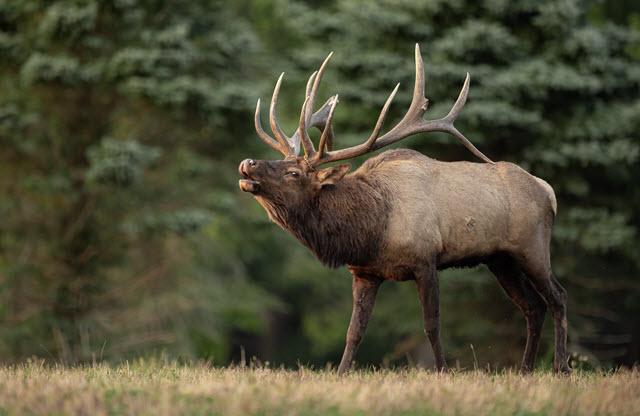
Elk bulls are famous for having incredibly enormous antlers. The male elk will grow a new set of antlers every year. This takes place in the spring and summer. The antlers have a velvet-covering in the summer months. The velvet is there to give the growing antlers protection from damage. The velvet eventually comes off when it’s rubbed off in the latest part of the summer.
Today, there are around 72,000 North American elk in North America. British Columbia is the province with the highest elk population, as more than half of all elk in the country are round there. As there has been worry and concern about North American elk populations, be extra careful to learn about the laws and regulations in your region if you plan to hunt them.
Third-Heaviest Deer Species in the World: The Sambar
Sambar deer are the third-heaviest type of deer found on the planet. Their average weight of this species is 400 pounds (or 180 kilograms). The weight range is between 100 and 350 kilograms.
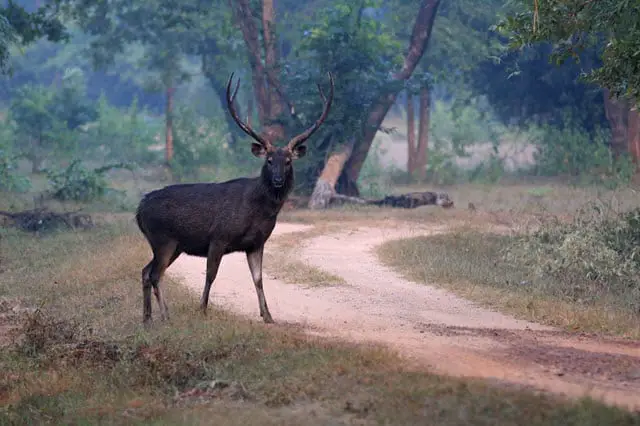
Sambar deer are found in India, southern China, Java, Sri Lanka, Sumatra, Pakistan, Malaysia, Borneo, the Philippines, Burma, Taiwan, and Ceylon.
There are also some places in the world where this species has been introduced, such as Texas, Florida, and California in the United States, as well as Australia and New Zealand. This deer needs tropical climates, including both tropical dry forests and tropical moist forests.
Final Thoughts About Deer Weight Variations
As we’ve seen here, there are dozens of different deer species all around the world and each has its own average weight range.
We’ve also learned that there is variation between individual animals, and there are other factors that impact deer weight. We have also explored the different types of weight that deer hunters need to understand and use as they go hunting and use the meat from the animals. Without this knowledge, hunters are likely to end up with significant meat wastage.
How much does a deer weigh? It depends on the type of deer, gender of the deer, time of year, and a variety of other factors. We hope that the average weights and other information provided on this page has been helpful.

